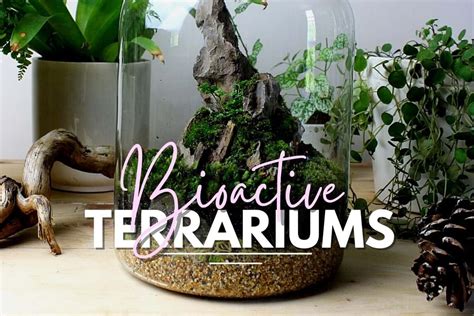The temperature of your bioactive terrarium is one of the most important factors to consider when keeping animals. The wrong temperature can cause stress, illness, and even death. The following guide will help you create a bioactive terrarium that provides the perfect temperature for your animals.

What is a Bioactive Terrarium?
A bioactive terrarium is a terrarium that contains live plants, animals, and microorganisms that all interact with each other to create a self-sustaining ecosystem. Bioactive terrariums are becoming increasingly popular because they are more naturalistic and require less maintenance than traditional terrariums.
Why Temperature is Important in a Bioactive Terrarium
The temperature of a bioactive terrarium affects the activity levels of the animals, the growth of the plants, and the decomposition of organic matter. The ideal temperature range for a bioactive terrarium will vary depending on the species of animals that you are keeping. However, most bioactive terrariums should be kept between 70 and 85 degrees Fahrenheit.
How to Measure the Temperature in a Bioactive Terrarium
The best way to measure the temperature in a bioactive terrarium is to use a digital thermometer. Place the thermometer in the center of the terrarium, about 2 inches above the substrate. Take readings at different times of the day to get an accurate average temperature.
How to Adjust the Temperature in a Bioactive Terrarium
There are several ways to adjust the temperature in a bioactive terrarium:
- Use a heat lamp: Heat lamps can be used to raise the temperature in a bioactive terrarium. Place the heat lamp on one side of the terrarium, and create a temperature gradient so that the animals can move to a cooler area if they need to.
- Use a heat mat: Heat mats can be placed under the substrate of a bioactive terrarium to provide gentle heat from the bottom. Heat mats are a good option for animals that prefer a warmer environment.
- Use a fogger: Foggers can be used to increase the humidity in a bioactive terrarium, which can help to cool the air. Foggers are a good option for animals that prefer a more humid environment.
- Use live plants: Live plants can help to regulate the temperature in a bioactive terrarium by absorbing heat and releasing moisture. Plants that are known for being good at regulating temperature include ferns, mosses, and vines.
Common Temperature Problems in Bioactive Terrariums
The most common temperature problems in bioactive terrariums are:
- The terrarium is too hot. This can be caused by using too much heat lighting or by keeping the terrarium in a warm location. Symptoms of a terrarium that is too hot include panting, lethargy, and heatstroke.
- The terrarium is too cold. This can be caused by using too little heat lighting or by keeping the terrarium in a cold location. Symptoms of a terrarium that is too cold include shivering, inactivity, and reduced appetite.
- The temperature is fluctuating too much. This can be caused by using the wrong type of heat source or by allowing the terrarium to experience too much drafts. Symptoms of a terrarium with fluctuating temperatures include stress, illness, and even death.
Conclusion
The temperature of your bioactive terrarium is one of the most important factors to consider when keeping animals. The ideal temperature range for a bioactive terrarium will vary depending on the species of animals that you are keeping. However, most bioactive terrariums should be kept between 70 and 85 degrees Fahrenheit. By monitoring the temperature of your terrarium and making adjustments as needed, you can help to create a healthy and thriving environment for your animals.
FAQs
1. What is the best way to measure the temperature in a bioactive terrarium?
The best way to measure the temperature in a bioactive terrarium is to use a digital thermometer. Place the thermometer in the center of the terrarium, about 2 inches above the substrate. Take readings at different times of the day to get an accurate average temperature.
2. How can I adjust the temperature in a bioactive terrarium?
There are several ways to adjust the temperature in a bioactive terrarium:
- Use a heat lamp
- Use a heat mat
- Use a fogger
- Use live plants
3. What are the common temperature problems in bioactive terrariums?
The most common temperature problems in bioactive terrariums are:
- The terrarium is too hot
- The terrarium is too cold
- The temperature is fluctuating too much
4. How can I prevent temperature problems in a bioactive terrarium?
By monitoring the temperature of your terrarium and making adjustments as needed, you can help to prevent temperature problems. You should also make sure to provide your animals with plenty of hiding places and water so that they can regulate their own temperature.
Reviews
1. “This article was very helpful in creating a bioactive terrarium for my leopard gecko. I was able to create a perfect temperature gradient for him, and he seems to be thriving in his new environment.”
2. “I have been keeping bioactive terrariums for years, and I have always found that the temperature is one of the most important factors to consider. This article provides a comprehensive overview of the different ways to measure and adjust the temperature in a bioactive terrarium.”
3. “I am new to bioactive terrariums, and this article was a great resource for me. I learned a lot about the importance of temperature and how to create the perfect environment for my animals.”
4. “I would highly recommend this article to anyone who is interested in creating a bioactive terrarium for their animals.”





















